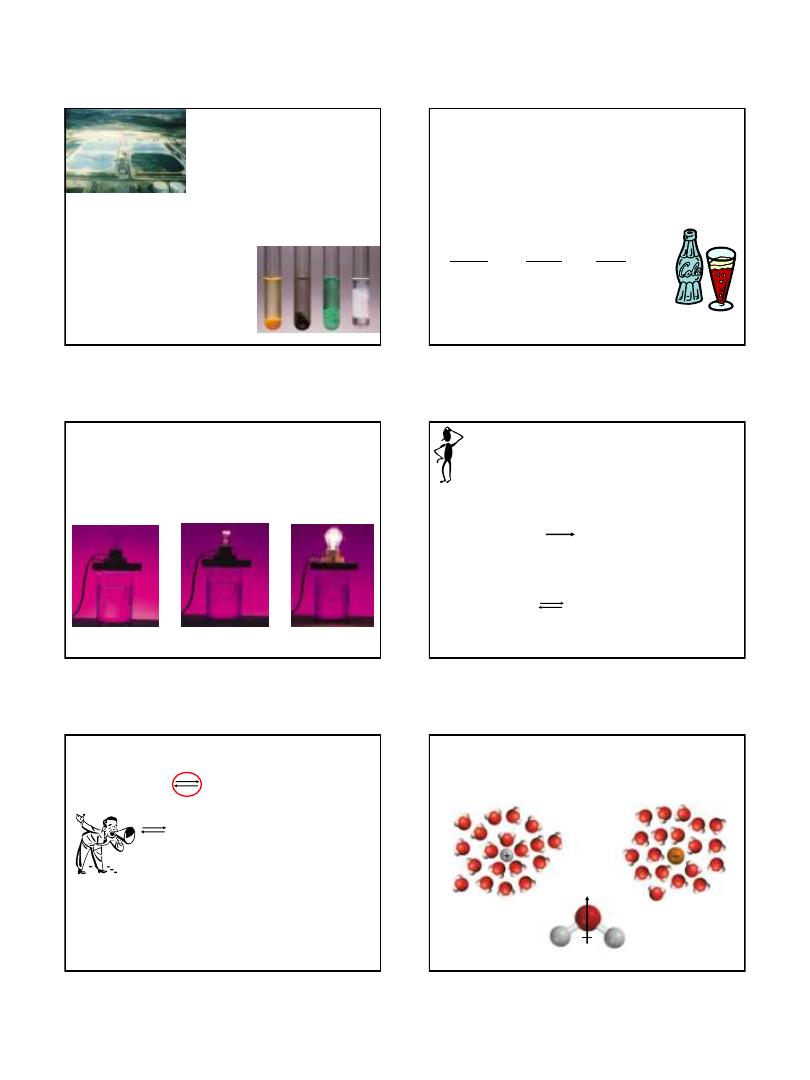
10/31/2012
1
Reactions in Aqueous Solution
Chapter 4
Copyright © The McGraw-Hill Companies, Inc. Permission required for reproduction or display.
4.1
A solution is a homogenous mixture of 2 or more
substances
The solute is(are) the substance(s) present in the
smaller amount(s)
The solvent is the substance present in the larger
amount
Solution
Solvent
Solute
Soft drink (l)
Air (g)
Soft Solder (s)
H
2
O
N
2
Pb
Sugar, CO
2
O
2
, Ar, CH
4
Sn
An electrolyte is a substance that, when dissolved in
water, results in a solution that can conduct electricity.
A nonelectrolyte is a substance that, when dissolved,
results in a solution that does not conduct electricity.
nonelectrolyte
weak electrolyte
strong electrolyte
4.1
Strong Electrolyte
– 100% dissociation
NaCl (s) Na
+
(aq) + Cl
-
(aq)
H
2
O
Weak Electrolyte
– not completely dissociated
CH
3
COOH CH
3
COO
-
(aq) + H
+
(aq)
Conduct electricity in solution?
Cations (+)
and Anions (-)
4.1
Ionization of acetic acid
CH
3
COOH CH
3
COO
-
(aq) + H
+
(aq)
4.1
A reversible reaction. The reaction can
occur in both directions.
Acetic acid is a weak electrolyte because its
ionization in water is incomplete.
Hydration is the process in which an ion is surrounded
by water molecules arranged in a specific manner.
d
+
d
-
H
2
O
4.1
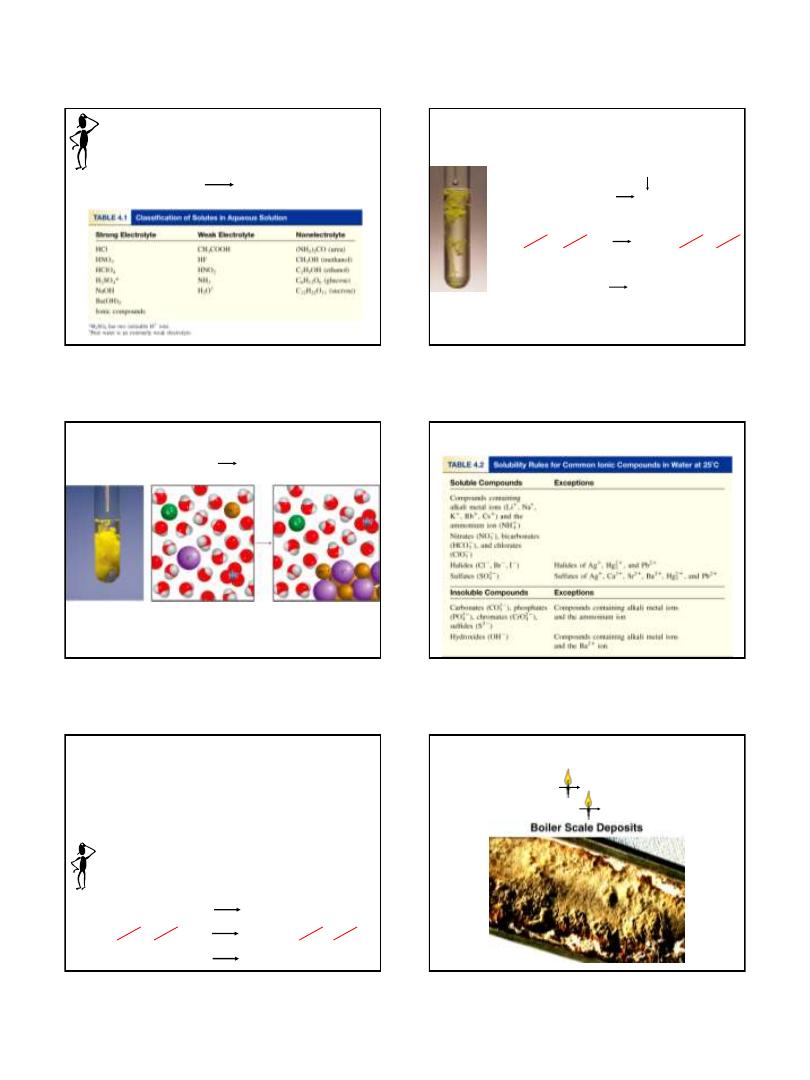
10/31/2012
2
Nonelectrolyte does not conduct electricity?
No
cations (+)
and anions (-) in solution
4.1
C
6
H
12
O
6
(s) C
6
H
12
O
6
(aq)
H
2
O
Precipitation Reactions
Precipitate
– insoluble solid that separates from solution
molecular equation
ionic equation
net ionic equation
Pb
2+
+ 2NO
3
-
+ 2Na
+
+ 2I
-
PbI
2
(s) + 2Na
+
+ 2NO
3
-
Na
+
and NO
3
-
are
spectator
ions
PbI
2
Pb(NO
3
)
2
(aq)
+ 2NaI
(aq)
PbI
2
(s)
+ 2NaNO
3
(aq)
precipitate
Pb
2+
+ 2I
-
PbI
2
(s)
4.2
Precipitation of Lead Iodide
PbI
2
Pb
2+
+ 2I
-
PbI
2
(s)
4.2
4.2
Solubility is the maximum amount of solute that will dissolve
in a given quantity of solvent at a specific temperature.
Writing Net Ionic Equations
1. Write the balanced molecular equation.
2. Write the ionic equation showing the strong electrolytes
completely dissociated into cations and anions.
3. Cancel the spectator ions on both sides of the ionic equation
4. Check that charges and number of atoms are balanced in the
net ionic equation
AgNO
3
(aq) + NaCl (aq) AgCl (s) + NaNO
3
(aq)
Ag
+
+ NO
3
-
+ Na
+
+ Cl
-
AgCl (s) + Na
+
+ NO
3
-
Ag
+
+ Cl
-
AgCl (s)
4.2
Write the net ionic equation for the reaction of silver
nitrate with sodium chloride.
Chemistry In Action:
CO
2
(aq) CO
2
(g)
Ca
2+
(aq) + 2HCO
3
(aq) CaCO
3
(s) + CO
2
(aq) + H
2
O (l)
-
An Undesirable Precipitation Reaction
4.2
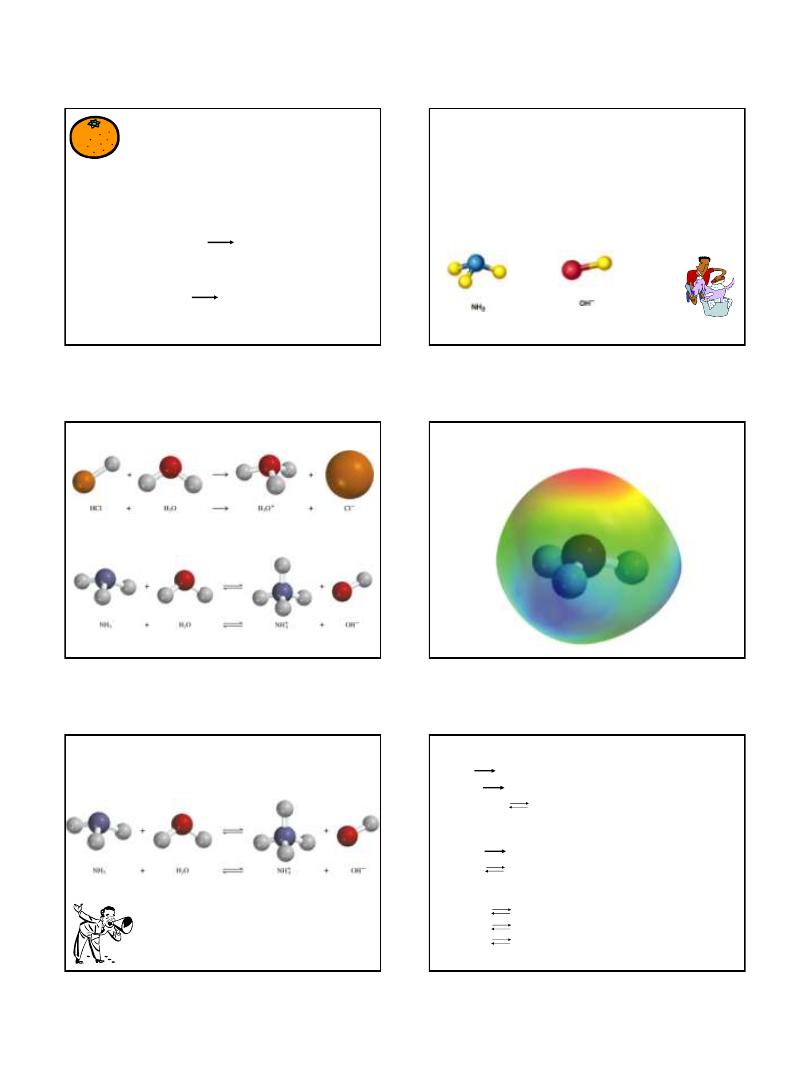
10/31/2012
3
Acids
Have a sour taste. Vinegar owes its taste to acetic acid. Citrus
fruits contain citric acid.
React with certain metals to produce hydrogen gas.
React with carbonates and bicarbonates to produce carbon
dioxide gas
4.3
Cause color changes in plant dyes.
2HCl (aq) + Mg (s) MgCl
2
(aq) + H
2
(g)
2HCl (aq) + CaCO
3
(s) CaCl
2
(aq) + CO
2
(g) + H
2
O (l)
Aqueous acid solutions conduct electricity.
Have a bitter taste.
Feel slippery. Many soaps contain bases.
Bases
4.3
Cause color changes in plant dyes.
Aqueous base solutions conduct electricity.
Arrhenius acid is a substance that produces H
+
(H
3
O
+
) in water
Arrhenius base is a substance that produces OH
-
in water
4.3
Hydronium ion, hydrated proton, H
3
O
+
4.3
A Brønsted
acid
is a proton donor
A Brønsted
base
is a proton acceptor
acid
base
acid
base
4.3
A Brønsted
acid
must contain at least one
ionizable proton!
Monoprotic acids
HCl H
+
+ Cl
-
HNO
3
H
+
+ NO
3
-
CH
3
COOH H
+
+ CH
3
COO
-
Strong electrolyte, strong acid
Strong electrolyte, strong acid
Weak electrolyte, weak acid
Diprotic acids
H
2
SO
4
H
+
+ HSO
4
-
HSO
4
-
H
+
+ SO
4
2-
Strong electrolyte, strong acid
Weak electrolyte, weak acid
Triprotic acids
H
3
PO
4
H
+
+ H
2
PO
4
-
H
2
PO
4
-
H
+
+ HPO
4
2-
HPO
4
2-
H
+
+ PO
4
3-
Weak electrolyte, weak acid
Weak electrolyte, weak acid
Weak electrolyte, weak acid
4.3

10/31/2012
4
Identify each of the following species as a Brønsted acid,
base, or both. (a) HI, (b) CH
3
COO
-
, (c) H
2
PO
4
-
HI (aq) H
+
(aq) + I
-
(aq)
Brønsted acid
CH
3
COO
-
(aq) + H
+
(aq) CH
3
COOH (aq)
Brønsted base
H
2
PO
4
-
(aq) H
+
(aq) + HPO
4
2-
(aq)
H
2
PO
4
-
(aq) + H
+
(aq) H
3
PO
4
(aq)
Brønsted acid
Brønsted base
4.3
Neutralization Reaction
acid
+
base
salt + water
HCl
(aq) +
NaOH
(aq) NaCl (aq) + H
2
O
H
+
+ Cl
-
+ Na
+
+
OH
-
Na
+
+ Cl
-
+ H
2
O
H
+
+
OH
-
H
2
O
4.3
Oxidation-Reduction Reactions
(electron transfer reactions)
2Mg 2Mg
2+
+ 4e
-
O
2
+ 4e
-
2O
2-
Oxidation half-reaction (lose e
-
)
Reduction half-reaction (gain e
-
)
2Mg + O
2
+ 4e
-
2Mg
2+
+ 2O
2-
+ 4e
-
2Mg + O
2
2MgO
4.4
4.4
Zn (s) + CuSO
4
(aq) ZnSO
4
(aq) + Cu (s)
Zn
is oxidized
Zn Zn
2+
+ 2e
-
Cu
2+
is reduced
Cu
2+
+ 2e
-
Cu
Zn
is the reducing agent
Cu
2+
is the oxidizing agent
4.4
Copper wire reacts with silver nitrate to form silver metal.
What is the oxidizing agent in the reaction?
Cu (s) + 2AgNO
3
(aq) Cu(NO
3
)
2
(aq) + 2Ag (s)
Cu Cu
2+
+ 2e
-
Ag
+
+ 1e
-
Ag Ag
+
is reduced
Ag
+
is the oxidizing agent
Oxidation number
The charge the atom would have in a molecule (or an
ionic compound) if electrons were completely transferred.
1. Free elements (uncombined state) have an oxidation
number of zero.
Na, Be, K, Pb, H
2
, O
2
, P
4
=
0
2. In monatomic ions, the oxidation number is equal to
the charge on the ion.
Li
+
, Li =
+1
; Fe
3+
, Fe =
+3
; O
2-
, O =
-2
3. The oxidation number of oxygen is usually
–2
. In H
2
O
2
and O
2
2-
it is
–1
.
4.4
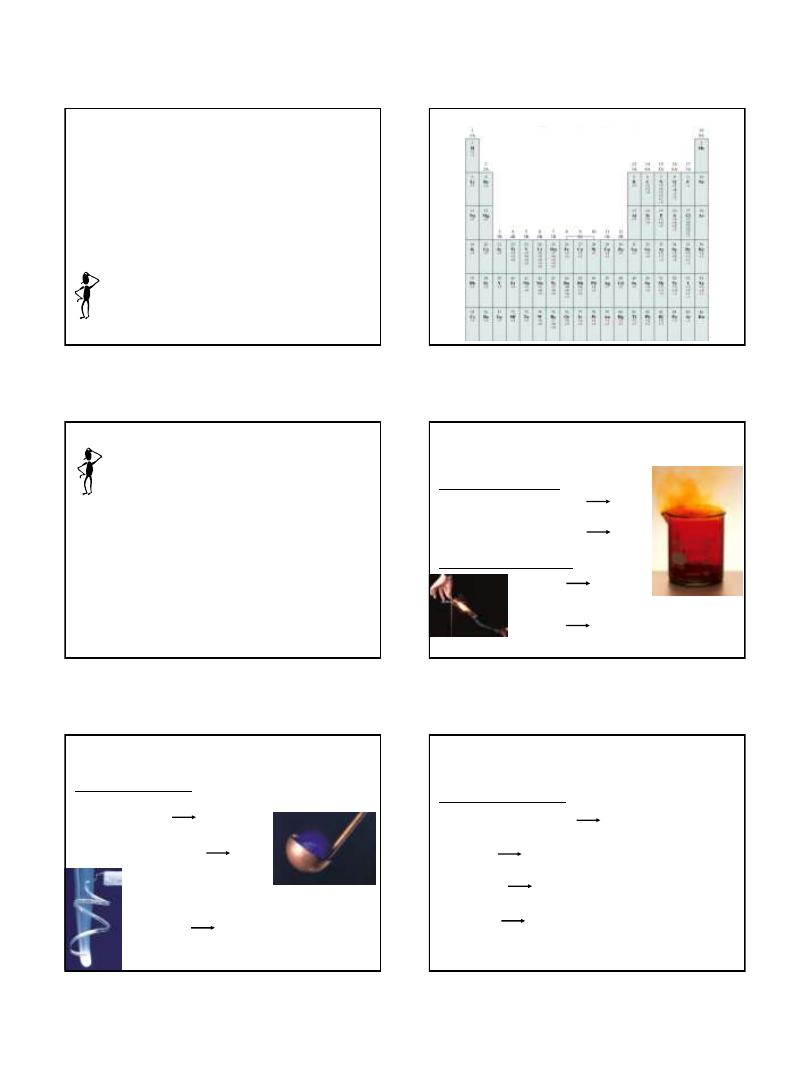
10/31/2012
5
4. The oxidation number of hydrogen is
+1
except when
it is bonded to metals in binary compounds. In these
cases, its oxidation number is
–1
.
6. The sum of the oxidation numbers of all the atoms in a
molecule or ion is equal to the charge on the
molecule or ion.
5. Group IA metals are
+1
, IIA metals are
+2
and fluorine is
always
–1
.
HCO
3
-
O =
-2
H =
+1
3x(
-2)
+
1
+
?
= -1
C =
+4
Oxidation numbers of all
the elements in HCO
3
-
?
4.4
7. Oxidation numbers do not have to be integers.
Oxidation number of oxygen in the superoxide ion,
O
2
-
, is
-½
.
The oxidation numbers of elements in their compounds
4.4
NaIO
3
Na =
+1
O =
-2
3x(
-2
) +
1
+
?
= 0
I =
+5
IF
7
F =
-1
7x(
-1
) +
?
= 0
I =
+7
K
2
Cr
2
O
7
O =
-2
K =
+1
7x(
-2
) + 2x(
+1
) + 2x(
?)
= 0
Cr =
+6
Oxidation numbers of all
the elements in the
following ?
4.4
Types of Oxidation-Reduction Reactions
Combination Reaction
A + B C
2Al + 3Br
2
2AlBr
3
Decomposition Reaction
2KClO
3
2KCl + 3O
2
C A + B
0
0
+3 -1
+1 +5 -2
+1 -1
0
4.4
Types of Oxidation-Reduction Reactions
Combustion Reaction
A + O
2
B
S + O
2
SO
2
0
0
+4 -2
4.4
2Mg + O
2
2MgO
0
0
+2 -2
Displacement Reaction
A + BC AC + B
Sr + 2H
2
O Sr(OH)
2
+ H
2
TiCl
4
+ 2Mg Ti + 2MgCl
2
Cl
2
+ 2KBr 2KCl + Br
2
Hydrogen Displacement
Metal Displacement
Halogen Displacement
Types of Oxidation-Reduction Reactions
4.4
0
+1
+2
0
0
+4
0
+2
0
-1
-1
0
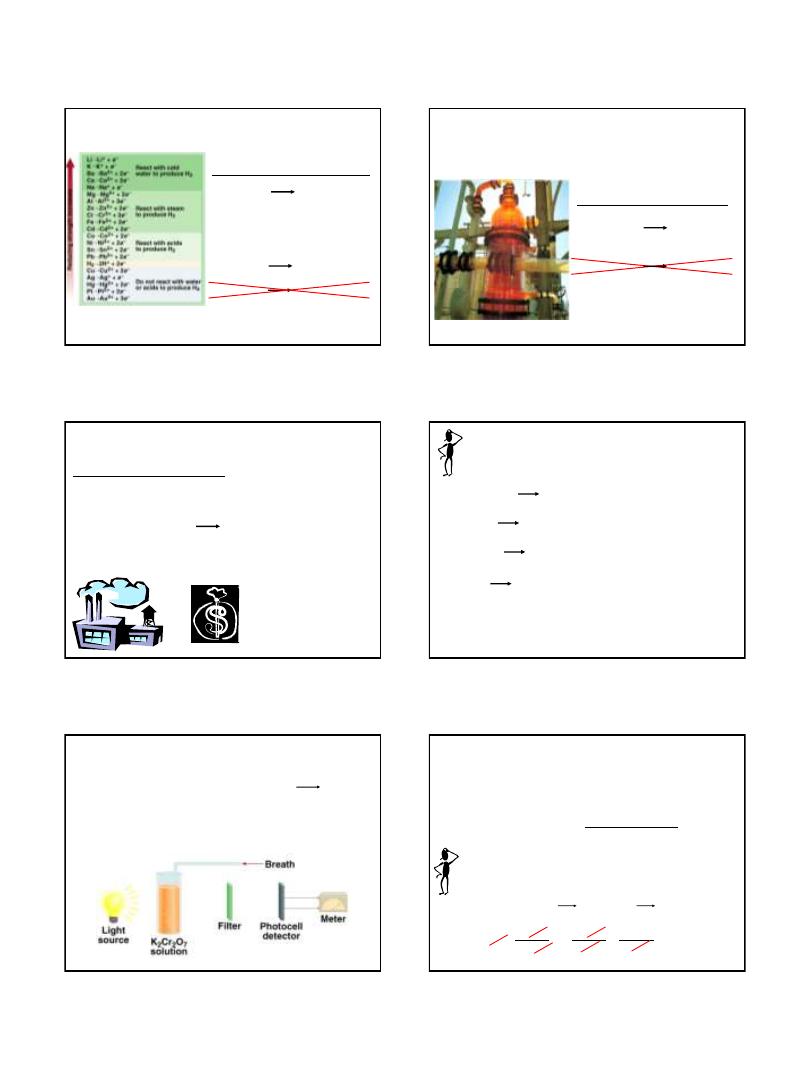
10/31/2012
6
The Activity Series for Metals
M + BC AC + B
Hydrogen Displacement Reaction
M is metal
BC is acid or H
2
O
B is H
2
Ca + 2H
2
O Ca(OH)
2
+ H
2
Pb + 2H
2
O Pb(OH)
2
+ H
2
4.4
The Activity Series for Halogens
Halogen Displacement Reaction
4.4
Cl
2
+ 2KBr 2KCl + Br
2
0
-1
-1
0
F
2
> Cl
2
> Br
2
> I
2
I
2
+ 2KBr 2KI + Br
2
Disproportionation Reaction
Cl
2
+ 2OH
-
ClO
-
+ Cl
-
+ H
2
O
Element is simultaneously oxidized and reduced.
Types of Oxidation-Reduction Reactions
Chlorine Chemistry
0
+1
-1
4.4
Ca
2+
+ CO
3
2-
CaCO
3
NH
3
+ H
+
NH
4
+
Zn + 2HCl ZnCl
2
+ H
2
Ca + F
2
CaF
2
Precipitation
Acid-Base
Redox (H
2
Displacement)
Redox (Combination)
Classify the following reactions.
4.4
Chemistry in Action: Breath Analyzer
4.4
3CH
3
COOH +
2Cr
2
(SO
4
)
3
+ 2K
2
SO
4
+ 11H
2
O
3CH
3
CH
2
OH +
2K
2
Cr
2
O
7
+ 8H
2
SO
4
+6
+3
Solution Stoichiometry
The concentration of a solution is the amount of solute
present in a given quantity of solvent or solution.
M = molarity =
moles of solute
liters of solution
What mass of KI is required to make 500. mL of
a 2.80 M KI solution?
volume of KI solution
moles KI
grams KI
M KI
M KI
500. mL
= 232 g KI
166 g KI
1 mol KI
x
2.80 mol KI
1 L soln
x
1 L
1000 mL
x
4.5

10/31/2012
7
4.5
Dilution is the procedure for preparing a less concentrated
solution from a more concentrated solution.
Dilution
Add Solvent
Moles of solute
before dilution (i)
Moles of solute
after dilution (f)
=
M
i
V
i
M
f
V
f
=
4.5
How would you prepare 60.0 mL of 0.200 M
HNO
3
from a stock solution of 4.00 M HNO
3
?
M
i
V
i
= M
f
V
f
M
i
= 4.00
M
f
= 0.200
V
f
= 0.06 L
V
i
= ? L
4.5
V
i
=
M
f
V
f
M
i
=
0.200 x 0.06
4.00
= 0.003 L = 3 mL
3 mL of acid + 57 mL of water = 60 mL of solution
Gravimetric Analysis
4.6
1. Dissolve unknown substance in water
2. React unknown with known substance to form a precipitate
3. Filter and dry precipitate
4. Weigh precipitate
5. Use chemical formula and mass of precipitate to determine
amount of unknown ion
Titrations
In a titration a solution of accurately known concentration is
added gradually added to another solution of unknown
concentration until the chemical reaction between the two
solutions is complete.
Equivalence point
– the point at which the reaction is complete
Indicator
– substance that changes color at (or near) the
equivalence point
Slowly add base
to unknown acid
UNTIL
the indicator
changes color
4.7
What volume of a 1.420 M NaOH solution is
Required to titrate 25.00 mL of a 4.50 M H
2
SO
4
solution?
4.7
WRITE THE CHEMICAL EQUATION!
volume acid
moles acid
moles base
volume base
H
2
SO
4
+ 2NaOH 2H
2
O + Na
2
SO
4
4.50 mol H
2
SO
4
1000 mL soln
x
2 mol NaOH
1 mol H
2
SO
4
x
1000 ml soln
1.420 mol NaOH
x
25.00 mL
= 158 mL
M
acid
rx
coef.
M
base

10/31/2012
8
Chemistry in Action: Metals from the Sea
CaCO
3
(s) CaO (s) + CO
2
(g)
Mg(OH)
2
(s) + 2HCl (aq) MgCl
2
(aq) + 2H
2
O (l)
CaO (s) + H
2
O (l) Ca
2+
(aq) + 2OH (aq)
-
Mg
2+
(aq) + 2OH (aq) Mg(OH)
2
(s)
-
Mg
2+
+ 2e
-
Mg
2Cl
-
Cl
2
+ 2e
-
MgCl
2
(aq)
Mg
(s)
+ Cl
2
(g)
